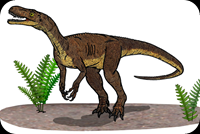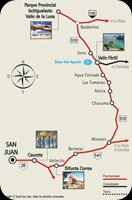Dinosaurs of the Ischigualasto Formation.
 The Ischigualasto Formation contains Late Triassic (Carnian) deposits (231.4 -225.9 million years before the present), with some of the oldest known dinosaur remains, which are the world's first with regards to quality, number and importance.
The Ischigualasto Formation contains Late Triassic (Carnian) deposits (231.4 -225.9 million years before the present), with some of the oldest known dinosaur remains, which are the world's first with regards to quality, number and importance.  It is the only place in the world where nearly all of the Triassic is represented in an undisturbed sequence of rock deposits. This allows for the study of the transition between dinosaurs and ancient mammals; research is ongoing.
It is the only place in the world where nearly all of the Triassic is represented in an undisturbed sequence of rock deposits. This allows for the study of the transition between dinosaurs and ancient mammals; research is ongoing. Badlands of the Valle de la Luna
The arid badlands around the formation are known as Valle de la Luna ("Valley of the Moon") due to their rugged, otherworldly appearance. In the Carnian this area was a volcanically active floodplain dominated by rivers and had a strongly seasonal rainfall.
Petrified tree trunks of Protojuniperoxylon ischigualastianus more than 40 m (131 ft) tall attest to a rich vegetation at that time. Fossil ferns and horsetails have also been found.
Rhynchosaurs and cynodonts are by far the predominant findings among the tetrapod fossils in the park. Dinosaurs comprise only 6% of the findings, but these include early samples of the two major lineages of dinosaurs (ornithischians and saurischians).
The carnivorous archosaur Herrerasaurus is the most numerous of these dinosaur fossils. Another important putative dinosaur with primitive characteristics is Eoraptor lunensis, found in Ischigualasto in the early 1990s.
Chromogisaurus
Eodromaeus
Eoraptor
Herrerasaurus
Panphagia
Pisanosaurus
If you liked this article, subscribe to the feed by clicking the image below to keep informed about new contents of the blog:



Comments
Post a Comment
Do not insert clickable links or your comment will be deleted. Check the Notify me notifications to be notified via email of new comments. If I helped you with the post or with the answers to the comments, share on Facebook or Twitter. Thank you.